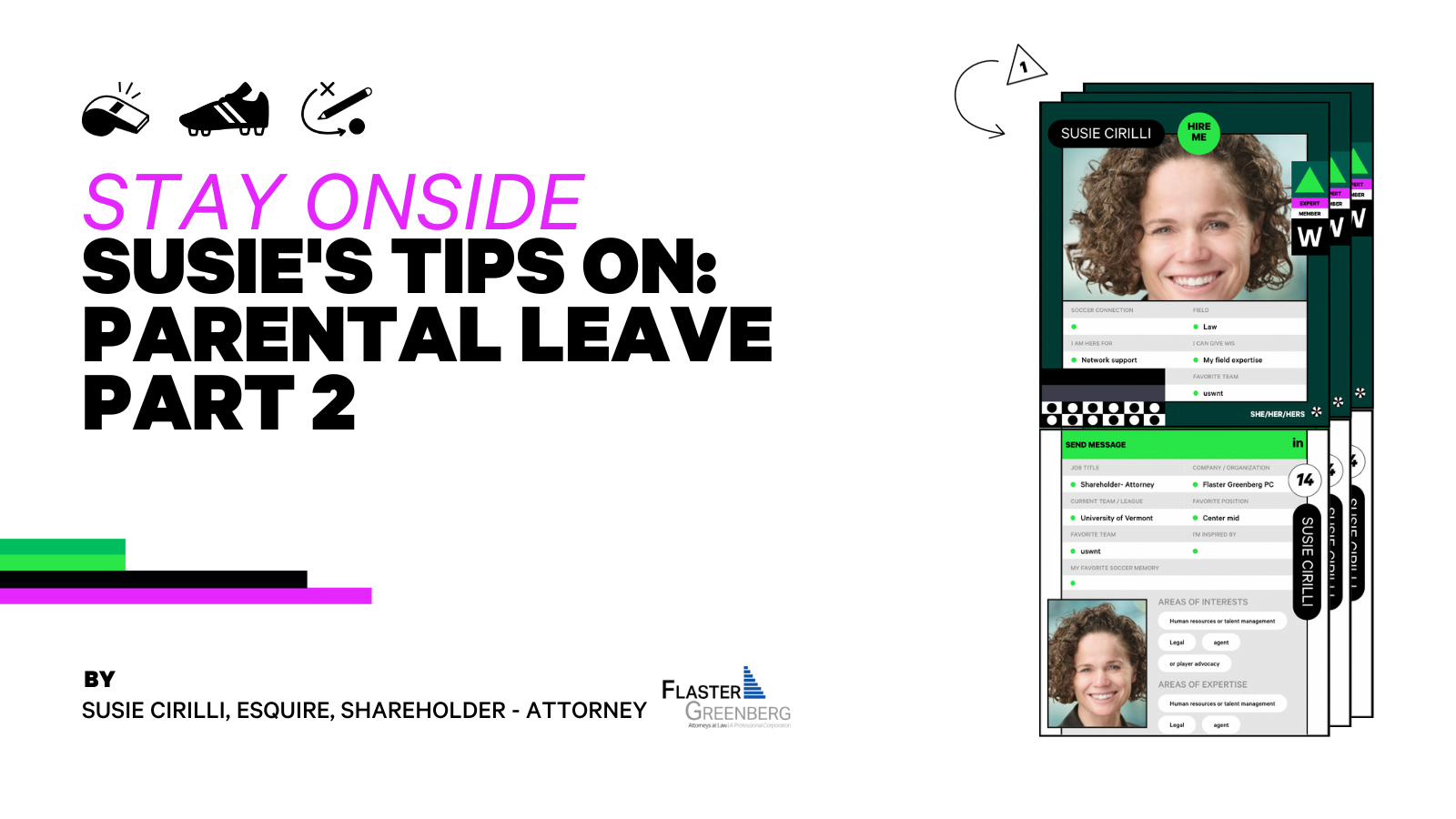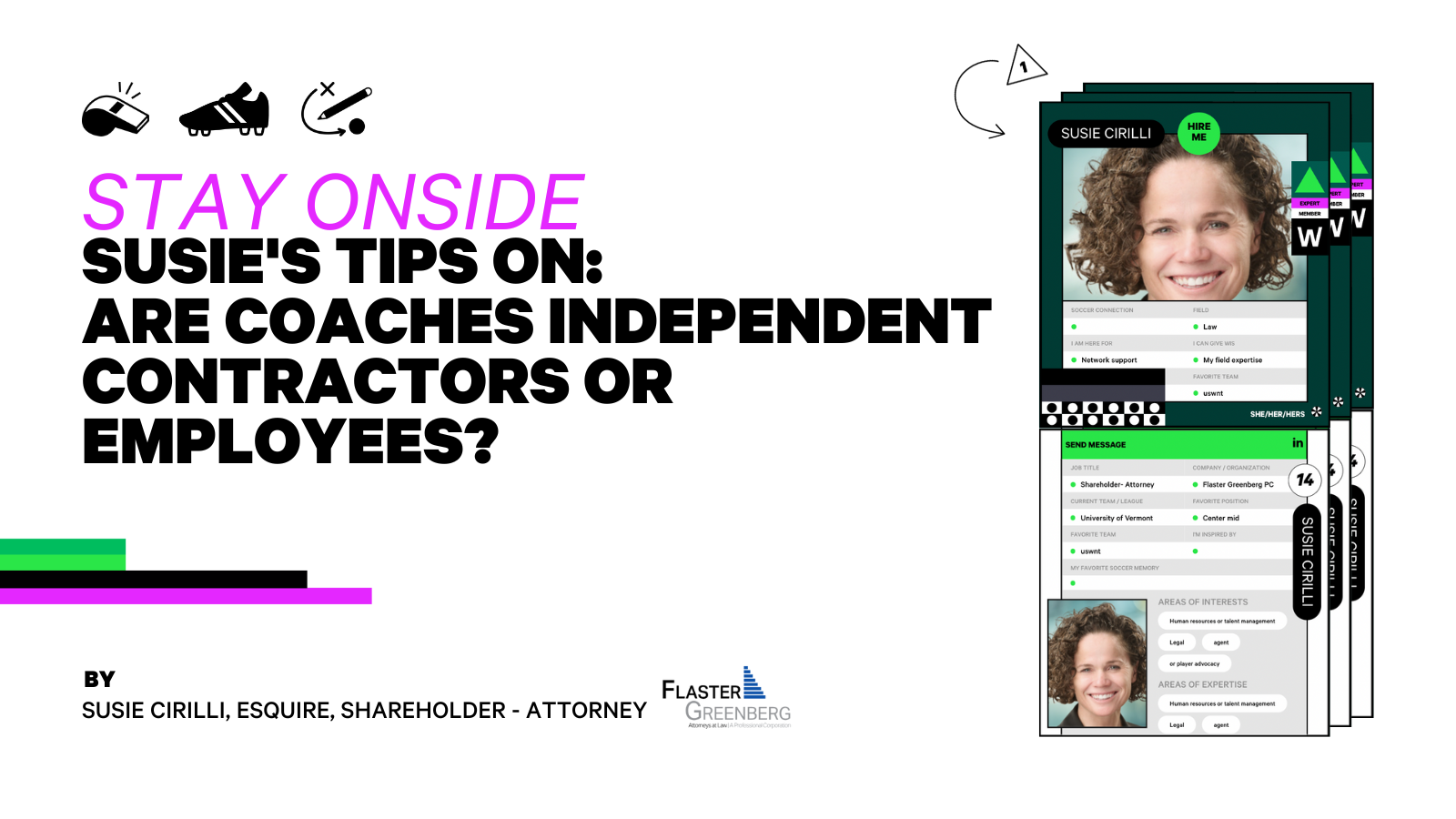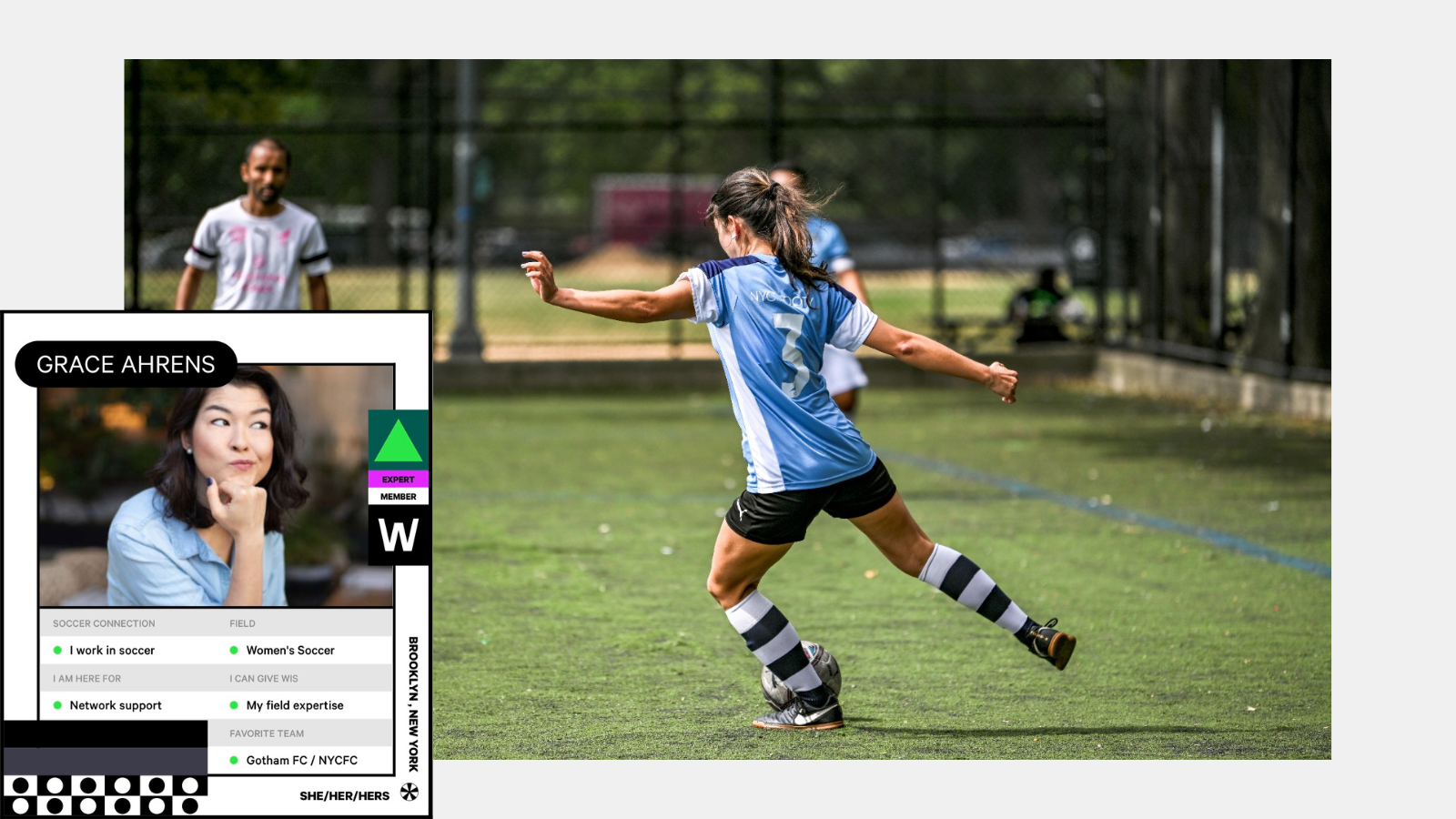FMLA LEAVE AND ATHLETES
As we discussed in the previous blog, Clubs must be well versed in the Collective Bargaining Agreements (CBA) and the Individual Player’s Contract when addressing employee (player) leave for childbirth, adoption, complications from pregnancy, and any other related scenarios. In addition to these documents, prudent organizations must consult any league handbooks and manuals. The next step is for the organization to understand the laws that apply to their organization for back-office employees and the employees on the pitch (players).
THE FAMILY MEDICAL LEAVE ACT
WHAT IS THE FMLA?
FMLA is a federal law that provides for 12 weeks of unpaid protected leave for employees in a 12-month period. This means that employees (players) can take leave for a Qualifying Reason (explained below), and take 12 weeks away from work. The individual is entitled to the same or equivalent position at the end of the 12-week period.
(NOTE: This blog gives a high-level overview of the FMLA, and does not cover every aspect of the law. With that being said, vigilant clubs will consult with counsel on (a) how to calculate the 12-month period, (b) reinstatement of the employee after the 12-week period, (c) intermittent leave, among other things.)
DOES IT APPLY TO MY CLUB?
This is a nuanced question. Let’s break it down…
- Any Person Engaged in Commerce with 50 or More Employees.
- The FMLA applies to “any person engaged in commerce or any industry or activity affecting commerce who employs 50 or more employees for each working day during each of 20 or more calendar workweeks in the current or preceding calendar year.”
- We are a Soccer Club! Not a Person! The FMLA defines person as an: individual, partnership, association, corporation, business trust, legal representative, or any organized group of persons. So, a soccer club falls under the definition of Person under the FMLA.
- We Play Soccer, We are Not “Engaged in Commerce!” The FMLA uses the definition of “commerce” from an old school law, the Labor Management Relations Act (LMRA). “Commerce” includes trade, traffic, commerce, transportation, or communication among several states. Professional Sports Clubs are most certainly engaged in commerce.
- We are a New Club, we only have 5 employees. This is a nuanced issue. First, an organization could be on the hook to provide FMLA Leave (“Covered Employer) under a Joint Employer theory or an Integrated Employer theory. We’ll break this down a little more…
- Clubs Must Consider Their Organizational Structure When Counting Towards the 50 Employees
- As we have seen, some teams are part of a larger entity comprised of multiple teams and organizations. So while a Club may only have a coach, a GM and a few players, that club may be a Covered Employer (and have to provide FMLA). Clubs must also consider their relationship with the league itself. Organizations should consult with counsel as franchise status may affect this evaluation.
- Integrated Employer Test. When evaluating whether a club is an “Integrated Employer” the following factors are weighed: (1) Common Management, (2) Interrletaion between operations, (3) Centralized Control of labor relations, (4) degree of common ownership, and (5) financial control.
- Joint Employer Test. A Club is “Joint Employer” when “two or more businesses exercise some control over the work or working conditions of the employee…” A Joint Employer exists when there are two separate and distinct entities, with separate owners and managers and even facilities.
WHO IS ELIGIBLE FOR THIS LEAVE?
Individuals can take FMLA leave if they are an Eligible Employee. This means that the employee must be employed for 12 months and work at least 1,250 hours. For more information on this specific topic, check out this blog.
WHY CAN SOMEONE TAKE THIS LEAVE?
Eligible Employees may take this leave for the following reasons (“Qualifying Reasons”):
- Birth of a child.
- Care for a newborn.
- Placement of a child with the employee through adoption or foster care (remember our note in the previous blog on the NWSL CBA and foster care).
- The employee’s own serious health condition that makes the employee unable to perform the functions of the job.
- Leave related to a qualifying exigency or to care for a covered servicemember.
- Care for a child or parent with a serious health condition.
Looking at this in the context of a leave related to pregnancy and children, it follows that a Club must consider the FMLA any time an employee (player):
- gives birth
- their partner gives birth
- fosters or adopts a child
- experiences complications after giving birth
- their partner experiences complications after giving birth
- the child has a serious health condition
WHAT ABOUT THE CBA AND PLAYER CONTRACT?
If there is a controlling CBA and Player Contract, organizations must consult with those documents. Contracts usually have terms for whether the unpaid FMLA leave will run concurrently with the paid leave.
For instance, the NWSL CBA provides for 8 weeks of paid leave related to birth or adoption. It also reads that the Parental Leave will run “concurrently with any entitled to unpaid leave in accordance with applicable federal or state law.” Let’s look at an example to see what concurrent leave looks like:
EXAMPLE #1- Adoption No Complications
- Sally NWSL Striker adopts a child on May 1, 2023.
- Sally takes the 8 weeks of Parental Leave under the CBA. This is paid leave.
- Sally is entitled to 12 weeks of protected leave under the FMLA.
- Under the NWSL CBA, Sally can take 12 weeks of leave and get paid for 8 of them.
EXAMPLE #2- Birth No Complications
- Sally NWSL Striker gives birth to a child on May 1, 2023.
- Sally takes 8 weeks of Parental Leave under the CBA. This is paid leave.
- Sally is entitled to 12 weeks of protected leave under the FMLA.
- Under the NWSL CBA, Sally can take 12 weeks of leave and get paid for 8 of them.
EXAMPLE #3- Adoption w/ Child Complications
- Sally NWSL Striker adopts a child on May 1, 2023.
- Sally takes the 8 weeks of Parental Leave under the CBA. This is paid leave.
- Sally is entitled to 12 weeks of protected leave under the FMLA.
- The adopted child experiences a serious health condition on week 7.
- Sally is entitled to the remaining 5 weeks of FMLA leave, because the child has a serious health condition.
- Under the NWSL CBA, Sally will take the full 12 weeks of leave and get paid for 8 of them. If the serious health condition should continue for the adopted child, beyond the 12 weeks, Sally will have to look into local leave laws and/or work with the employer for time off.
EXAMPLE #4- Birth w/ Complications of Individual Who Gave Birth
- Sally NWSL Striker gives birth to a child on May 1, 2023.
- Sally takes 8 weeks of Parental Leave under the CBA. This is paid leave.
- Sally is entitled to 12 weeks of protected leave under the FMLA.
- At week 6, Sally develops a serious health condition as a result of giving birth.
- Under the NWSL CBA, it is unclear whether the Pregnancy Benefit and the Parental Leave Benefit run concurrently.
- Regardless, Sally is eligible for 8 weeks of Paid Leave under the Parental Leave Benefit, and additonal time under the Pregnancy Benefit. The result is that Sally receives 12 weeks of paid leave, and then subsequent time for the shorter of (1) the duration of her inability to play, or (2) the remainder of Sally’s Player Agreement.
EXAMPLE #4- Birth w/ Complications of Child
- Sally NWSL Striker gives birth to a child on May 1, 2023.
- Sally takes 8 weeks of Parental Leave under the CBA. This is paid leave.
- Sally is entitled to 12 weeks of protected leave under the FMLA.
- At week 6, the child develops a serious health condition.
- Under the NWSL CBA, it is unclear whether the Pregnancy Benefit applies to this scenario. The Pregnancy Benefit applies when a player “cannot render the services required…as a result of the Player’s pregnancy..” It is unclear as to whether this applies to situations when the newborn has a serious medical condition.
- Regardless, Sally is eligible for 8 weeks of Paid Leave under the Parental Leave Benefit and maybe additional time under the Pregnancy Benefit.
MY CLUB IS A COVERED EMPLOYER. WHAT DO I HAVE TO DO?
- Train your HR folks on the FMLA. These professionals must be aware of when an employee makes a request for FMLA leave and what needs to be done. Employers must respond to a request within 5 days. Even more, employees must be trained on what constitutes a request for FMLA. The federal regulations are clear that employees do not need to say the magic words “I need FMLA” or even say the letters “FMLA.”
- Notice Poster. The regulations require that entities post this (or something like that). Failure to post carries a $204 fine. Also, this is required even if an employer is not a Covered Employer.
- FMLA Policy in Handbook. The regulations require that all Covered Employers include an FMLA policy in their handbook.
Prudent organizations will consult with counsel regarding implementing policies and procedures when faced with an FMLA issue. The regulations and statutes provide a protocol for employers when communicating with employees who request leave and while they are on leave. That is beyond the scope of this blog.
STATE LAW CONSIDERATIONS
It is important to note that the FMLA is a federal law. There are many states that have their own “mini-FMLA” laws that cover such leave.
Examples of States With Their Own Family Leave Laws (* means paid leave) :
- Wisconsin *
- California *
- Colorado *
- Connecticut *
- Delaware *(effective January 1, 2025)
- District of Columbia *
- Maryland *
- Massachusetts *
- Michigan *
- Minnesota *
- New Hampshire *
- New Jersey *
- New York *
- Oregon *
- Rhode Island *
- Washington*
- Illinois
- Tennessee
NOTE: Some of these states carve out exceptions for employees covered by a CBA. With that being said, this means that the organization must consider the state law for the employees that are NOT covered by the CBA (ie- coaches, staff, back office people). Lastly, some cities have their own family leave ordinances. For instance while Pennsylvania does not have its own Family Leave law, the city of Philadelphia has its own leave law. Consult with local counsel to confirm which laws apply to which employees.
FINAL THOUGHTS
Employee leave is a topic that implicates multiple laws and controlling documents. As we discussed in the first blog, organizations cannot ignore any CBA or Player Contracts. As we discussed in this blog, organizations must also consider the FMLA and how that relates to employee leave. The next blog will be on employer (club) considerations when an employee (player) experiences a disability related to childbirth. We will look at the Americans with Disabilities Act and the recently enacted Pregnant Workers Fairness Act.








